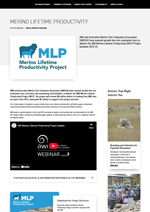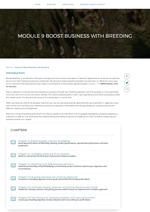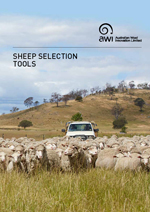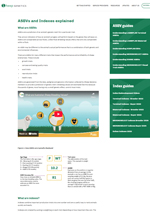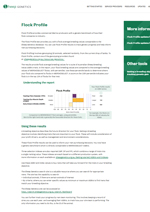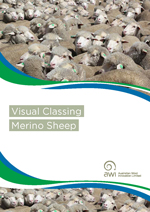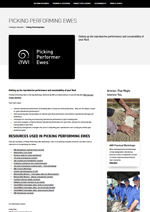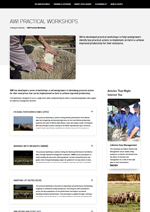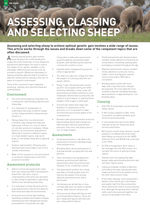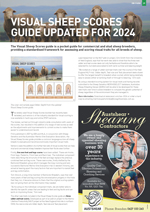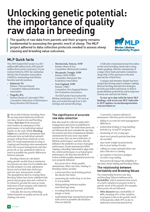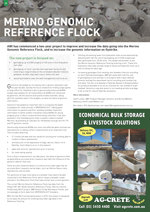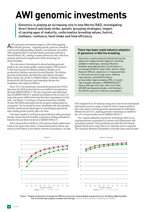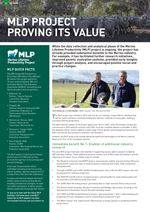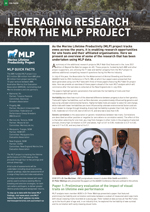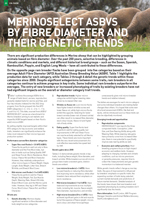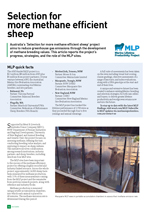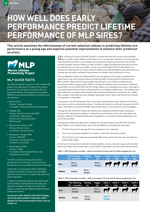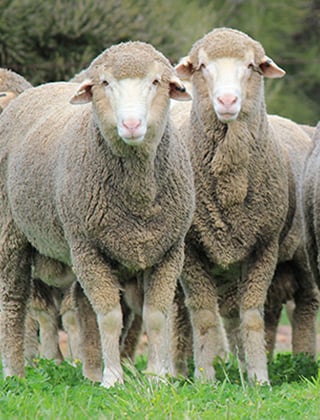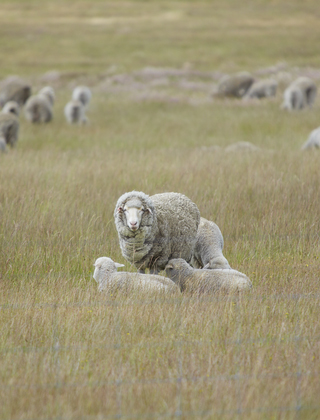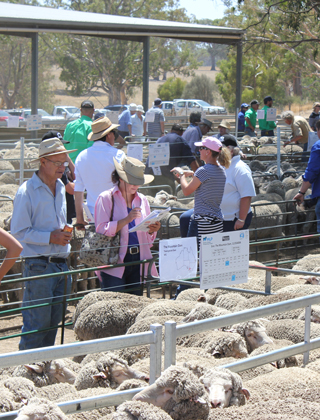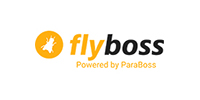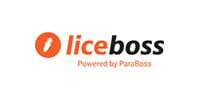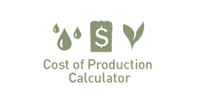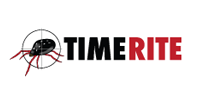Merino Lifetime Productivity project update
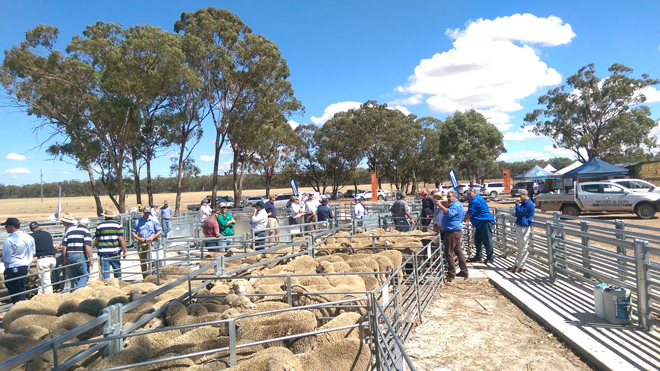
The Merino Lifetime Productivity (MLP) project is currently analysing more than 2,000,000 data points to gain deeper insights into breeding and selection methods applied at early ages. The objective is to refine the industry's recommendations so that producers can achieve improved lifetime profitability.
MLP QUICK FACTS
The AWI-funded MLP project is a $13 million ($8 million from AWI plus $5 million from project partners), 10-year venture between AWI, Australian Merino Sire Evaluation Association (AMSEA), nominating stud Merino breeders, and site partners.
- Balmoral, Vic
Partner: Tuloona Pastoral
Committee: Balmoral Breeders Association - Pingelly, WA
Partner: Murdoch University/UWA
Committee: Federation of Performance Sheep Breeders (WA Branch) - MerinoLink, Temora, NSW
Partner: Moses & Son
Committee: MerinoLink Limited - Macquarie, Trangie, NSW
Partner: NSW DPIRD
Committee: Macquarie Sire Evaluation Association - New England, NSW
Partner: CSIRO
Committee: New England Merino Sire Evaluation Association
The MLP project has tracked the lifetime performance of 5,700 ewes as they proceeded through four to five joinings and annual shearings.
A full suite of assessments has been taken on the ewes including visual trait scoring, classer gradings, and objective measurements of a range of key traits and Index evaluations, along with a DNA genotype at the start and end the of their lives.
A unique and extensive dataset has been created that is being used to enhance existing Merino breeding and selection strategies, for both ram sellers and buyers, to deliver greater lifetime productivity and woolgrower returns, selecting both rams and ewes at young ages, now and into the future.
To stay up to date with the latest MLP findings, visit www.wool.com/MLP. Subscribe to MLP updates via www.merinosuperiorsires.com.au/contact-us
The MLP project has been a 10-year industry partnership to develop a dataset that captures lifetime performance of Merinos across environments and genotypes.
Launched in 2015, the project joined 5,700 ewes – the daughters of 134 sires – across five diverse Australian sites over 4–5 joinings. It collected more than 2,000,000 data points to build an industry resource for the analysis of lifetime performance – both in terms of productivity and profitability.
On its tenth anniversary, AWI Program Manager, Sheep Genetics & Animal Welfare Advocacy, Geoff Lindon, provided an update on the MLP project via webinar. The 45-minute webinar presentation, followed by a 45-minute Q&A session was recorded and is available for viewing at www.wool.com/MLP.
This article provides a summary of some of the key points from the webinar.
Data submitted to MERINOSELECT: The MLP data has been submitted to the MERINOSELECT database. This has not only enhanced genetic analysis as a whole, it has also enabled several new traits to have the data they required to be released to industry. It has improved the accuracy and accessibility of genomic breeding technologies and reporting to the Merino industry.
New Weaning Rate trait: MLP assisted with the creation of the new Weaning Rate (WR) trait and its three component traits: Conception Rate (CON), Litter Size (LS) and Ewe Rearing Ability (ERA).
MERINOSELECT index updates: MLP has assisted with the MERINOSELECT analysis and Index updates in 2022 and 2024 and will again for the coming updates. All ASBVs are now genomically enhanced, including adult traits.
Sires bred with and without ASBVs: Analysis shows that the sires in the MLP project bred with and without ASBVs show similar end results when comparing MERINOSELECT Index figures, but the way they get to the final figure is different. The non-ASBV bred rams showed improved Adult Clean Fleece Weight (ACFW), whilst those bred with ASBVs showed improved Yearling Fat (YFAT), Yearling Eye Muscle Depth (YEMD), Yearling Worm Egg Count (YWEC) and Weaning Rate (WR) figures.
Better predictions at younger ages: The MLP project focusses on sire reranking across years and improving early predictions of adult traits. Currently the sires that tend to rise in fleece weight ranking between Post Weaning (P) and Adult (A) ages tend to be later maturing, high fleece value animals, and those that fall tend to be earlier maturing, low wrinkle sires (although there are outliers that complicate this assessment). When breeding animals for lower wrinkle but aiming to optimise fleece weight, there needs to be added focus on hogget and adult age fleece weight traits. The current analysis into maturity patterns and better very young age predictions is reviewing this further.
Importance of adult fleece weight ASBVs:
Hogget and adult fleece wool accounts for 60–90% of total wool production. The remaining 10–40% comes from one-year-old post-weaner or yearling wool. The exact proportions vary depending on factors such as sheep type, breeding objectives, time of shearing, and when young wethers and ewes are sold.
Where Hogget or Adult direct assessments are not possible (flock rams are sold by 14–15 months and even some ewe classing is moving earlier before they cut their teeth), genomics can increase the accuracy of their Hogget and Adult age trait predictions, so it still adds transparency to display these traits even when a direct measure at Hogget or Adult age has not been taken.
Given the dominance of Hogget and Adult wool, growers that are seeking to optimise lifetime wool production need to have a good focus on hogget and adult age fleece weight traits.
Making Adult fleece weight ASBVs more readily accessible to ram and semen buyers adds transparency for this important economic trait.
MLP ‘Add On’ projects: The MLP project spawned many MLP ‘Add On’ projects which enhanced the outputs and knowledge built during the project. These have shown:
- Poor udders reduce Weaning Weight and lamb survival.
- Resilience is not correlated with wool traits. There is a small unfavourable correlation with Weaning and Yearling Weight and a small favourable correlation with Dag and Worm Egg Count.
- Fat and Weaning Rate are lowly correlated, but it is best to select directly for Weaning Rate (WR) if it is an important trait in your breeding objective.
- Skin pigment at early ages is a good indication of lifetime pigment.
- Mid-side wool sampling is best for measuring yield, even in drought conditions when there’s high dust penetration.
- There is promise in Methane breeding values, with Project Breeding Values created and work ongoing to collect more data to complete analysis.
- There is a 20–30% difference in whole body fat between sires of the same liveweight, and this is highly correlated with carcase fat depth.
- Testing levels of anti-mullerian hormone (AMH) at three months of age in Merinos is not a good indicator of lifetime Weaning Rate (unlike some other species).
- Improving meat eating quality traits – such as Intramuscular Fat (IMF) and Shearforce (SF5) – has no unfavourable impact on wool traits.
- It is possible to have a breeding value for flystrike, and pilot Project Breeding Values for breech strike and body strike were released in January 2025.
Assessment protocols: Assessment protocols are critical for both visual and measured assessments:
- Classing can be cost-effective when selecting for traits that can be assessed visually (fleece weight and body weight)
- Breeding Values work and accumulate data across years
- Both require quality protocols, performance assessments and raw data
- Assessments at 18–22 months of age are more predictive of lifetime wool production and progeny performance than using 9-month-old Post Weaning or 12-month-old Yearling data. Including at least one late Hogget or Adult fleece record on ewes improves productivity and progeny performance predictions.
Feed efficiency: Outcomes from the AWI-funded MLP Add On project ‘Genetic evaluation of productivity, efficiency and profitability’ (GEPEP) will be fully reported throughout 2026 (as soon as it is finished). The recently updated feed standards have been incorporated into the project analysis. The outcomes will start to be adopted in future MERINOSELECT analysis and Index reviews and thereafter as the knowledge in this important efficiency area grows.
Gross margin per DSE and profit per hectare: In the forthcoming economic analysis, both gross margin per DSE and profit per hectare will be reported. Once completed, these will be promoted widely and made publicly available at wool.com/MLP and form a significant part of the MLP communications throughout 2026.
Analysis of sire mating success: All the lambs born into the MLP project were DNA parentage tested, which has allowed for interesting analysis. One such example is sire mating success, which looked at the number of F2 progeny marked per sire, per joining. One standout was a ram at the MLP New England site that ended up with 231 progeny from a single joining (in a high twinning rate year) – this was four times higher than the average ram progeny numbers. Top 20% rams sired more than eight times more progeny on average than bottom 20% rams across the five MLP sites.
Scientific publications: Where copyright allows, all scientific publications will be uploaded to wool.com/MLP (most will be eligible for posting). These scientific publications will also be summarised into more targeted information for woolgrowers to use practically on-farm.
MLA Flock Profile tool: MLA has released the Flock Profile tool where commercial Merino growers can DNA test 20 random ewe hoggets and receive a report that benchmarks their genetics to the now large Merino reference population. MLA is also about to release within flock genomic only breeding values for individually DNA tested animals. This opens up the benefits of genomics to woolgrowers outside the ASBV system, making genomic technology available all woolgrowers.
Ongoing analysis: Data collection was completed in August 2024 and validated. Analysis of those 2,000,000+ data points from diverse sires, ewe bases, environments, and sites is continuing. Topics currently being worked on include:
- Full genetic parameter estimates
- Better ways of predicting Adult traits at very young ages
- Economic analysis, including gross margin/DSE and profit/ha and their correlation with Indexes
- Economic benefit and cost of fat and body weight
- A benefit-cost analysis of visual and measured assessments.
More results are coming: The MLP project’s impact will keep growing as the analysis continues. Woolgrowers can look forward to new insights and practical tools to boost breeding decisions, enhance genetic evaluations, and improve on-farm profitability and sustainability.
Early results have already offered valuable tips on reproduction, wool production, and the power of combining visual and objective assessments – but there’s much more to come. Stay tuned for economic analyses, breeding program insights, and evidence-based recommendations.
Further information and resources
AWI Beyond the Bale articles
This article appeared in the Spring 2025 edition of AWI’s Beyond the Bale magazine that was published in September 2025. Reproduction of the article is encouraged.






